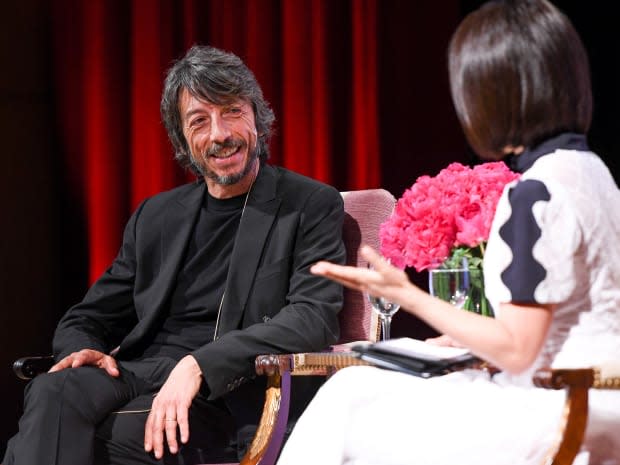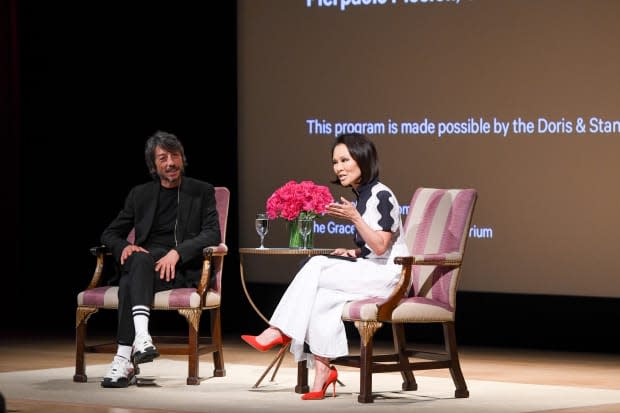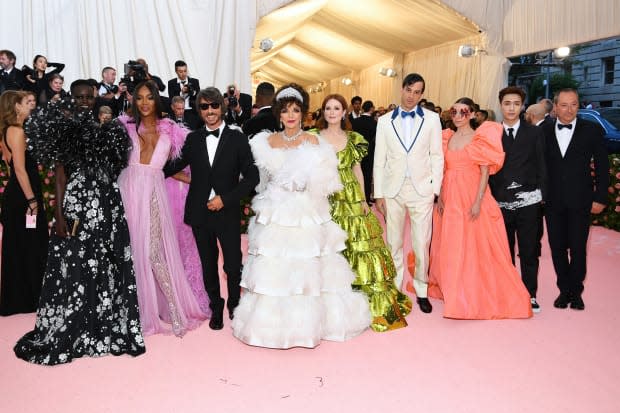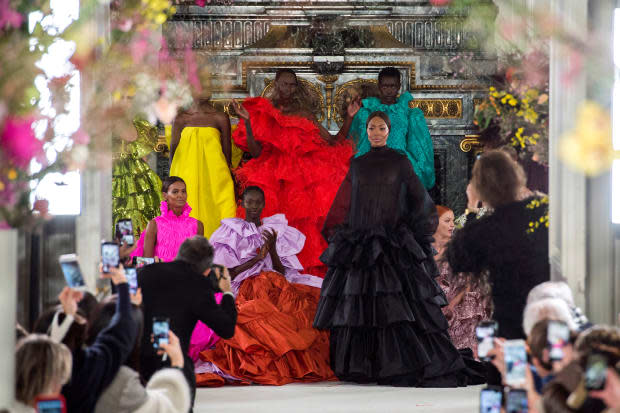Pierpaolo Piccioli on His 'Time' 100 Honor, Promoting Diversity and Modernizing Valentino
Plus, his thoughts on the Met Gala and why he changed his mind about logos.

Cinematography punctuated much of Pierpaolo Piccioli's childhood in a small coastal town about 20 miles outside of Rome. He spent a great deal of his time watching and enjoying movies, eventually convincing himself he wanted to be a director. But the cinematic world, with its glamour and fantasy, eventually got Piccioli fascinated with fashion — so much so that he decided that would be his mode of storytelling.
Still, through all of his lofty endeavors in the fashion world, Piccioli remained connected to his cinematic roots, carrying the values he garnered from that with him. On Tuesday night, during a chat with Alina Cho at the Metropolitan Museum of Art for her conversation series "The Atelier," he explained that, just as a good director must maintain their signature style while telling different stories, so must a good designer. "I think the values have to be the same — I'm not going to change values season by season. I change the way [I] deliver the values," he said.
Over the course of his conversation with Cho, Piccioli discussed those values, from maintaining diversity to staying connected with his family, while gracing the audience with a few only-in-fashion stories (like Donatella Versace telling Piccioli that she wanted to burn the pink Valentino Couture dress Lady Gaga wore to the Italy premiere of "A Star Is Born" because it was so fabulous). Below are some of the highlights from the creative director's conversation with Cho.

On Dressing Stars for the Met Gala
For the 2019 Met Gala, Joan Collins, Naomi Campbell, Adut Akech, Julianne Moore, Mark Ronson, Lykke Li, Lay Zhang and Stefano Sassi were all dressed in Valentino and attended the event with Piccioli. Though the gala's camp theme eluded many interpretations, Piccioli felt right at home with its bombastic and eccentric frame of reference.
"I really like the idea of camp as the freedom of being whoever you want to be today... Camp doesn't mean the niche of extravagant people, but it means the freedom to be whoever you want to be. That, for me, is the most inspiring thing that I get from this exhibition," he told Cho.
As for his chosen guests, he wanted that to be based on something deeper than dressing only A-list celebrities. "All of [the guests] together represent what I want Valentino to represent today — the idea of inclusivity, of diversity, of different kinds of people."

On Being Named One of 'Time' 100's Most Influential People
Earlier this year, Piccioli was named one of Time 100's most influential people. Actor Frances McDormand wrote the designer's blurb for the list, saying, "His reign in the House of Valentino has been a lesson in grace. He feels no need to erase the past but builds on its foundation and by doing so makes the future of the house stronger, braver."
When Cho asked how he felt about the honor, Piccioli expressed how important it is to deliver his values through his work. Being listed in the Time 100 confirmed that he is doing just that.
"You really understand that you can do something like fashion, but you can also say something you believe in. You can shape the world in the way you want. I think I'm more relevant when I do fashion than if I do politics. I think I'm not very good at politics," he explained, referencing his early interest in politics while he attended Rome's Istituto Europeo di Design.
On Navigating Family Life While Helming the Valentino Legacy
Picciolo, who married his high school sweetheart and has three children with her, lit up when he spoke about his family with Cho. He laughed as he told the audience that his children and wife are still surprised when people stop him to take a selfie because to them, he's simply their father and husband. Still, despite the adjustment to his fame in the fashion world, they remain extremely supportive of all that he does at Valentino.
"The only way to have a family and to have a job like this is to have people that even if they don't really understand [me] in all of the things [I do], they still support me," he said. "Good or bad — here we are."
But there is one rule in his household that he quickly learned not to break to keep the peace: Picciolo does not tell his wife what to wear. He made the mistake of offering her his couture-trained eye once, and she quickly put a stop to that. "She told me, 'Please, don't talk to me as a designer. Talk to me as my husband. I'm beautiful [in whatever] I'm wearing,'" he recalled to the audience, who promptly broke out in a round of applause.
On How He Embraced Becoming the Lone Leader of Valentino
When Piccioli became the sole creative director for Valentino after Maria Grazia Chiuri's departure, there was a lot of speculation about what she would take with her and what would remain of the iconic fashion house in her absence. As fashion critics were hashing that out in glossy pages and online, Piccioli was doing the same in his own head, attempting to understand how much of the brand's evolving DNA was his alone.
It was Piccioli's daughter who unintentionally gave him the wisdom and insight to plunge into the unknown and unchartered when she discussed with him German philosopher Friedrich Nietzsche's theory on memory, as part of her high school studies. In the theory, Nietzsche argues that nostalgia paralyzes man and doesn't allow him to act.
"In order to look forward, [a man] must be aware of his past, but in a way, he has to forget his past. Being aware [but] just looking forward instinctively — I'd say that's me in this moment," Piccioli explained.
To remain grounded in his purpose with Valentino, the designer still lives in the small town he grew up in, far away from couture and high fashion.
"When you grow up in a place like that that's far from everything, you just dream," he said. "And I still live there because I still want to maintain that... I have much more than I could ever imagine in my life. I don't want to become a different kind of guy. I don't want to forget how far everything was from me, and I don't want today to be spoiled by all this work. I want to maintain these kind of dreamy eyes."
On Embracing Logos and Creating the Stunning Image of Naomi Campbell on the New York Subway
In the spirit of letting go of nostalgia to move forward, Piccioli had to let go of his sentiments about logos and their place in fashion in order to embrace both the "VLTN" and "Vring" emblems that newly-frequent the Valentino repertoire. He was first challenged to do so when he noticed a lot of the younger members of his design team ordering the fashion house's old logo T-shirts from Amazon.
"I come from a culture in the '80s where the logo was the lowest part of fashion. Then [working] with the younger people, I always try to understand their point of view because they help me [conceptualize], progress thoughts and to see things with new eyes. I always say, 'Things change with how you look at [it],' so it's very important to keep up that kind of imagination between the reality of things and how you look at it," he said.
This growth in perspective culminated into Valentino's Pre-Fall 2019 campaign, featuring Naomi Campbell in a sparkling, emerald green dress, carrying a black leather "Vring" bag on the New York City subway.
"The bag was linking public spaces where people [are] every day in the most dreamy way," Piccioli said.
On Promoting Diversity Within the Couture World
As Piccioli was preparing for Valentino's Spring 2019 Couture collection, in which he featured predominantly Black models (including runway icon Campbell), he created a mood board that included Cecil Beaton's iconic shot of a group of white women in Charles James gowns. He considered how historically, magazines that featured Black celebrities and models, like Ebony and Jet, weren't able to borrow high-end clothes — they were instead forced to purchase them.
"I started thinking about how you can do modern couture. I was thinking of [Beaton's] picture — it may be the most iconic picture of couture. But couture is the field of individuality, of being one-of-a-kind. When it was born, it was just meant to be for white women. And I was thinking what if rather than just this one [type of woman], you put Black, modern women [in couture]," he explained.

He went on to say he doesn't believe that modernizing couture requires changing the classic style that's become so associated with it. "In order to make it modern couture, you have to give the couture to modern women," he said.
"[Valentino's Spring 2019 Couture] is not a niche couture," he said. "It was a very classic couture, with all the stereotypes of couture — ruffles, flowers, colors. [I] just changed the girls. That was enough to give a message that was a statement."
Want the latest fashion industry news first? Sign up for our daily newsletter.
